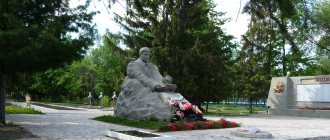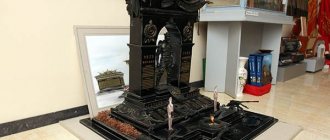Penza region is a subject of the Russian Federation. The region is located in the center of European Russia and is part of the Volga Federal District.
The administrative center of the region is the city of Penza.
It borders with the Ulyanovsk, Saratov, Tambov, Ryazan regions and the Republic of Mordovia.
The region was formed by the Decree of the Presidium of the Supreme Soviet of the USSR on February 4, 1939. The idea is being put forward to merge the Penza region and Mordovia into the Sursky Krai, with the center in Penza.
History of the region
Penza was founded in 1663 as a Russian fortress on the border of the Wild Field.
In 1719, the Penza province was formed as part of the Kazan province.
On September 15, 1780, the Penza province was formed, which existed until March 5, 1797, when the province was liquidated, and Penza became the district center of the Saratov province.
On September 9, 1801, the Penza province was restored and existed until 1928, the year of major administrative and territorial transformations in the USSR. In 1928, the province was liquidated, Penza became the center of the Penza district of the Middle Volga region, then the Kuibyshev region, and 9 years later (since 1937) - the regional center of the Tambov region.
On February 4, 1939, by decree of the Presidium of the Supreme Soviet of the USSR, the Tambov region was divided and the Penza region was formed, which exists to this day. In March 1939, the Penza Regional Committee of the All-Union Communist Party of Bolsheviks was created, and Alexander Kabanov became the first secretary of the regional committee.
When the Penza region was formed, it included: from the Tambov region - the city of Penza, Bashmakovsky, Bednodemyanovsky, Bessonovsky, Bolshe-Vyassky. Golitsynsky, Golovinshchinsky, Gorodishchensky, Zemetchinsky, Issinsky, Kamensky, Kerensky, Kondolsky, Luninsky, Mokshansky, Narovchatsky, Nizhne-Lomovsky, Pachelmsky, Poimsky, Svishchevsky, Sosedsky, Teleginsky, Ternovsky, Chembarsky and Shemysheysky districts; from the Kuibyshev region - Baranovsky, Kameshkirsky, Kuznetsky, Litvinovsky, Neverkinsky, Nikolaevsky, Nikolo-Pestrovsky districts; from the Saratov region - Bekovsky, Danilovsky, Kolyshleysky, Lopatinsky, Malo-Serdobinsky, Serdobsky, Tamalinsky districts. On January 19, 1943, Baranovsky and Nikolaevsky districts were transferred to the newly formed Ulyanovsk region.
Monument "First Settler"
In 1980, a monument was erected in Penza in memory of the first residents of this glorious city. The place and time of construction of the monument were chosen for a reason. About 600 years ago, from the date of construction of the monument, the Battle of Kulikovo took place. The city of Penza was built from the attack of steppe nomads who robbed border settlements, so the sculpture is directly related to this event. The monument itself depicts a peasant warrior who is ready not only to work in the field, but also to defend his homeland.
The installation location was also not chosen by chance; it not only offers an excellent view of the city, but also nearby there are the ruins of the city’s historical fortress.
Address: Kirova street.
Geography
The Penza region is located between 42° and 47° east longitude and between 54° and 52° north latitude.
- The length from west to east is 330 km.
- The length from north to south is 204 km.
- Area - 43.2 thousand km².
- The highest point in the territory is 342.037 m above sea level.
- The lowest point in the territory is 97.6 m above sea level.
The geographical center of the Penza region has coordinates 53°10'north latitude and 44°34'east longitude. The Penza region lies in a temperate geographical zone, at the junction of forest, forest-steppe and steppe natural zones.
The surface relief is flat, slightly hilly. The extreme west of the region belongs to the eastern edge of the Oka-Don Plain.
Hydrography
There are over 3,000 rivers and streams in the region with a total length of 15,458 km. The largest of the rivers - Sura, Moksha - belong to the endorheic basin of the Caspian Sea (Volga River); Khoper, Vorona (drainage basin of the Don River). The Penza River, a tributary of the Sura, gave its name to the regional center.
Protection of Nature
State Nature Reserve "Volga Forest-Steppe". The total area of the reserve is 8373 hectares. It contains thick chernozems, unique for the forest-steppe zone; steppe plant complexes have not been preserved anywhere else in Europe. It is distinguished by its unusual floristic richness and the presence of rare species of plants and animals listed in the Red Book. More than 860 species of vascular plants, more than 100 species of lichens, more than 70 species of bryophytes and about 120 species of fungi grow on its territory.
Flora
Natural vegetation has been preserved on about a third of the territory of the Penza region; forests occupy almost 20% of its area. The importance of forests is not so much industrial as they are water protection, soil protection and recreational. The steppes are mostly plowed.
There are about 1,500 species of higher plants on the territory of the Penza region.
The list of rare and endangered species in the Red Data Book of the Penza Region includes 156 species of vascular plants and 40 species of fungi.
On the territory of the Privolzhskaya Forest-Steppe Nature Reserve grows more than 860 species of vascular plants (over 55% of the species composition of the flora of the Penza region and 40% of the flora of the Middle Volga region), 108 species of lichens, 72 species of bryophytes and 119 species of fungi.
Fauna
The region is home to 316 species of vertebrates.
There are about 50 species of fish in the reservoirs of the Penza region. The largest, the Sursky Reservoir, has about 30 species. In total, 10 species of fish are listed in the region’s Red Book.
Minerals
The mineral resource base of the region consists mainly of raw materials for the construction industry. The region contains deposits of clays (including refractory and refractory), gypsum, glass sands, marl and chalk, opoka, coarse-grained molding sands, mineral pigments, limestone, diatomites, glauconites, as well as small accumulations of phosphorites suitable for grinding under phosphorite flour. Three oil fields have been explored in the region: Verkhozimskoye, Komarovskoye and Alekseevskoye, and there are peat deposits. Ore occurrences of titanium-zirconium placers have been identified.
Sculpture Park "Legend"
Not far from the village of Ramzai, there is a park that is hard to find analogues not only in Russia, but also in Europe. On a fairly large territory there are more than 400 exhibitions of various sculptors from the world. Every year more and more artists come here, they are paid for accommodation, food, and if they are lucky, one of the masterpieces will be able to stay at this exhibition and glorify its creator.
The competition for participation is quite tough, so the best remain here, which is a definite plus for tourists. For comparison, Norway has a similar park, but it is half the size of Legend. Having arrived here, a tourist may not even have time to see all the masterpieces in one visit, so it is recommended to visit this place more than once.
Attractions
- The main tourist attraction of the Penza region is the State Tarkhany Museum-Reserve - an estate of the late 18th - early 19th centuries, in which the poet Mikhail Yuryevich Lermontov spent his childhood.
- On the territory of the Chistye Prudy recreational complex near Ramsay there is the Legend sculpture park, famous for the annual holding of international sculpture symposiums. The Legend Park has 275 unique works of marble, granite, wood, metal, bronze, made by 178 sculptors from 59 countries.
Nikolsky Museum of Glass and Crystal
Nikolsky Museum of Glass and Crystal
Nikolsky district
In 1789, at the crystal factory of Alexei Bakhmetev in the city of Nikolskoye, a special storeroom was opened, which was also called the model room. The best products were stored there and then displayed at exhibitions.
In 1884, the plant was inherited by Prince Alexander Obolensky, a distant relative of the Bakhmetevs. The new owner replenished the museum collection with samples of foreign glass. Obolensky also brought to the storeroom decanters found at archaeological excavations in Kerch, which were made in the 1st century AD.
After the revolution, the plant was nationalized and renamed “Red Giant”, and the museum continued its work. His collection included products from Soviet glassmakers. In 1990, a new two-story building was built especially for the museum, which now houses the main exhibition.
Today the museum exhibits one of the largest collections of glass products in Russia, which includes over 14 thousand exhibits. Among them are cups that the factory produced in the 1750s by order of Catherine II, medallions depicting heroes of the Patriotic War of 1812, and a crystal table of Joseph Stalin.
Assumption Cathedral
One of the most beautiful old-type cathedrals is located in Penza. It was built in 1905 to replace an old wooden church that completely burned down. With the money of merchants and local residents, a Russian-style temple called the Assumption was built.
This is a truly huge structure that can be seen from many areas of the city. In 2005, the Assumption Cathedral celebrated its anniversary, and today it continues to perform its functions, and sometimes it hosts excursions for tourists.
Penza Women's Trinity Monastery
In the very center of Penza is the oldest temple in the city, built several decades after the founding of the city. Initially, on the site of the monastery there was an estate of the priest Peter Ivanov, who handed it over completely free of charge to two old nuns and their sisters in the faith.
Over the course of 300 years, the monastery has experienced a lot, from constant restorations to the partial demolition of some parts of the temple, but in the end it was able to survive to us. Today, services are held in the monastery, liturgy is conducted and excursions are conducted.
Address: Kirova street-25.
Museum and Exhibition Center of Zarechny
There is also something to see in a small closed city near Penza. Despite the fact that Zarechny is a closed city, you can get a pass in advance and visit this amazing place. In the museum you can learn about the history of the city and those people who lived here before it was founded. In addition to the history of the settlement, the museum has exhibits describing the life of the local residents, their characteristics and traditions.
Address: Sportivnaya street - 4.
Light and music fountain "Sputnik"
Now in Penza, in its very center, a beautiful musical fountain has appeared that attracts the attention of residents and guests of the city. The fountain is especially popular in late spring and summer, it is then that it begins to work at full power and you can watch the light and sound show performed by it.
The streams of water are not fenced in anything and children sometimes climb inside to play with them. In addition to the fountain itself, there is a park area with pedestrian and bicycle paths around it, a well-cut lawn and a beautiful embankment.
Penza Zoo
Penza Zoo appeared in 1981. With the importation of the first animals, they were provided with all the necessary living conditions and vast territories so that animals and birds could move as freely as possible inside.
In the 90s, this place began to fall into disrepair, but for the last 15 years, the zoo’s managers have been doing everything to ensure that it flourishes and develops. A visitor walking around the courtyard will immediately appreciate that even if the monkeys are in cages, they will not be cramped. Each place allocated for a specific animal is equipped in accordance with all state standards and does not restrict the movement of animals.
Address: Krasnaya street - 10.











